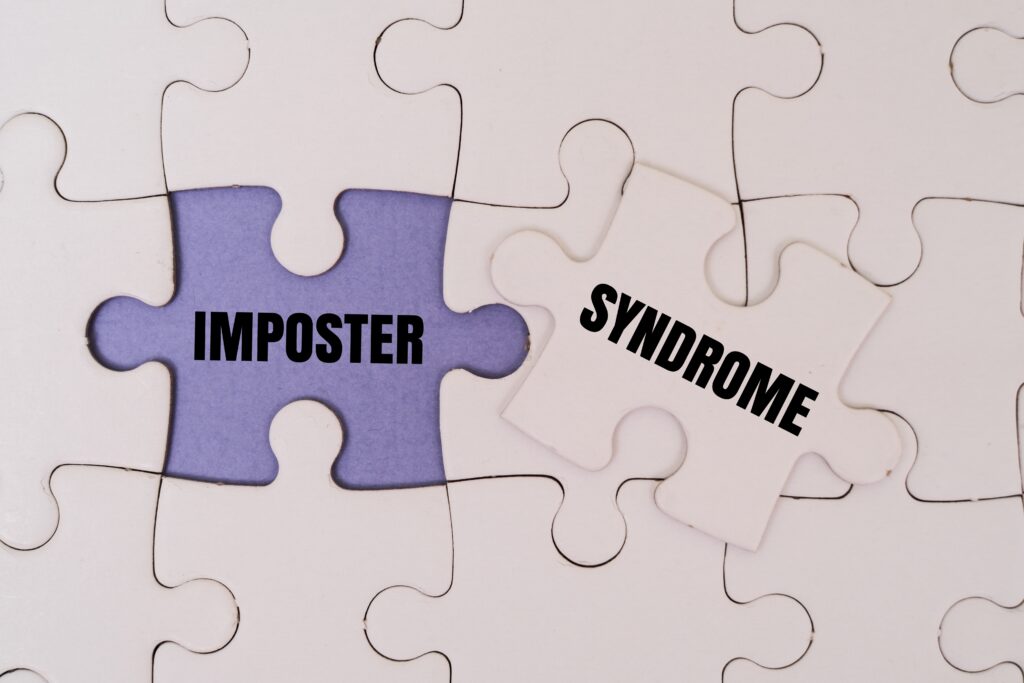Imposter syndrome can feel like you're stuck in a loop, you're working hard, doing well on the outside, and yet you're still feeling like you're winging it, worrying that it’s only a matter of time before someone realises you're not as capable as they think. It’s exhausting, and frustrating.
If this sounds familiar, you're not alone. I work with many people who are often high-achievers that struggle with the internal narrative of “not good enough.” It can result in coping strategies such as overworking, perfectionism, overthinking, procrastination, or avoiding opportunities altogether.
The good news is that you can change your relationship with imposter syndrome. It doesn’t have to keep running the show.
Let’s look at what’s really going on, and what can help.
1. Imposter Syndrome is Rooted in Threat and Protection
Imposter syndrome isn’t a flaw or a sign that something’s wrong with you, it’s a protective response. Underneath the surface, there’s often anxiety and fear about being judged, criticised, or exposed as not good enough. These fears are deeply human. From an evolutionary perspective, being accepted and approved of meant safety. Rejection felt dangerous.
Today, that same protective system still kicks in, especially in work settings, performance situations, or anything involving a sense of risk or vulnerability. The more it matters to you, the louder that inner critic and self-doubt can get.
Approaches like Acceptance and Commitment Therapy (ACT) and Compassion Focused Therapy (CFT) are helpful here. They allow us to step back from these internal narratives and understand them as parts of us trying to keep us safe—rather than absolute truths we need to obey or argue with.
2. Shame Often Sits at the Core
Imposter syndrome is rarely just about anxiety. Often, it’s tangled up with shame, the painful belief that there's something fundamentally wrong with you.
Unlike guilt “I did something wrong”, shame says, “I am wrong.” It’s often shaped by early experiences: criticism, high expectations, feeling overlooked or not good enough. When these experiences go unprocessed, they can leave lasting imprints on how we see ourselves.
CFT focuses directly on this. We work to understand where these feelings come from and begin developing a more compassionate and balanced ways of responding to these experiences.
3. Your Emotional Brain Needs More Than Logic
You might know, rationally, that you’re doing well. People tell you you’re capable, but it doesn’t sink in. That’s because your emotional brain isn’t convinced. It’s still responding as if you’re under threat.
This is why deeper therapeutic work—like EMDR—can be so valuable. EMDR helps process experiences where you felt judged, humiliated, inadequate, or unsafe. It allows the emotional part of the brain to re-evaluate and update, so those old responses no longer feel so current or so charged.
So What Can You Do Now?
While deeper work is important, there are also things you can start doing now to shift how you relate to imposter syndrome.
1. Awareness Training - Get better at noticing and recognising the Imposter Syndrome patterns
In order to address any problem we need to recognise it is a problem and then increase awareness of what the problem is and how it operates. This is very important with imposter syndrome. Learning to notice when imposter syndrome gets triggered,
2. Notice the Story — and Step Back From It
When thoughts like “I’m not good enough” or “I’m going to be found out” show up, notice them for what they are: thoughts, not facts. You don’t need to argue with them, and you don’t have to believe them, you can learn to treat them like an opinion that this part of you holds. It is more helpful to look at whether it is a helpful or useful opinion or not. What happens when you listen to it, take it seriously and act upon it. Like all opinions, you don't have to agree with it or follow it. Learn to talk back to your imposter syndrome, agree to disagree. Remember that this is your life, you are in charge and get to choose what you do or don't do.
3. Use Your Values to Guide Your Choices, Not Your Feelings
In understanding the problematic patterns of behaviour that you're getting stuck in, you will probably find that what you are doing is driven by your emotions, e.g., fear, doubt, worry, shame. Whilst this is understandable it is not helpful as it focuses on what is going to feel better or safer in the short-term. It can be a bit like scratching an itch, it provides short-term relief but the problem is the itch keeps returning and getting more agitated.
Having your emotions in the drivers seat is not helpful. In learning to put yourself in the drivers seat you can then start to use your values to guide and inform your behaviour. Do things because they matter to you, because it connects with what is important.
4. Be OK With Not Knowing
A common trap with imposter syndrome is believing you should know everything. But nobody does—and pretending you do only reinforces the fear of being found out.
Practice saying things like, “I’m not sure, but I’ll find out,” or “I’m still learning that.” These responses show confidence—not incompetence.
5. Stop Comparing Your Insides to Other People’s Outsides
We all do this. You feel unsure or anxious, then look around and assume everyone else is doing fine. But you’re seeing their curated external version—not what’s really going on inside.
The more you focus on your own values, learning, and growth, the less power these comparisons have.
6. Soothe Your Nervous System
Imposter syndrome doesn’t just live in your head—it shows up in your body. Fast heartbeat, tension, tight chest. Grounding and breathing techniques can help calm your system and create more space to respond.
In therapy exercises such as the following can be helpful to help work with the body:
-
Soothing Rhythm Breathing
- Dropping Anchor
These tools help you anchor yourself in the present rather than getting caught in anxious prediction.
Long-Term Change Comes from Understanding and Compassion
While these strategies help reduce the intensity of imposter feelings, long-term change often requires going deeper—working through the beliefs, experiences, and internal stories that feed the problem.
That’s where therapy comes in.
Whether it’s CBT to challenge harsh self-talk, ACT to build psychological flexibility, CFT to develop a kinder internal voice, or EMDR to process stuck emotional memories—change is possible.
Imposter syndrome doesn’t have to define you. You’re not broken or flawed. You’re someone who’s developed a pattern of coping—and like any pattern, it can change.
If this resonates with you and you'd like support in working through it, I’m here to help.
You can learn more about how I work or book an initial appointment via deanwatkinstherapy.co.uk.

